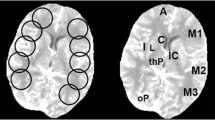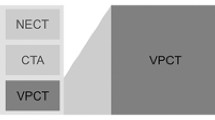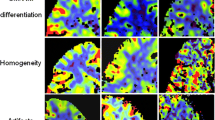Abstract
Objectives
To examine the impact of denoising on ultra-low-dose volume perfusion CT (ULD-VPCT) imaging in acute stroke.
Methods
Simulated ULD-VPCT data sets at 20 % dose rate were generated from perfusion data sets of 20 patients with suspected ischemic stroke acquired at 80 kVp/180 mAs. Four data sets were generated from each ULD-VPCT data set: not-denoised (ND); denoised using spatiotemporal filter (D1); denoised using quanta-stream diffusion technique (D2); combination of both methods (D1 + D2). Signal-to-noise ratio (SNR) was measured in the resulting 100 data sets. Image quality, presence/absence of ischemic lesions, CBV and CBF scores according to a modified ASPECTS score were assessed by two blinded readers.
Results
SNR and qualitative scores were highest for D1 + D2 and lowest for ND (all p ≤ 0.001). In 25 % of the patients, ND maps were not assessable and therefore excluded from further analyses. Compared to original data sets, in D2 and D1 + D2, readers correctly identified all patients with ischemic lesions (sensitivity 1.0, kappa 1.0). Lesion size was most accurately estimated for D1 + D2 with a sensitivity of 1.0 (CBV) and 0.94 (CBF) and an inter-rater agreement of 1.0 and 0.92, respectively.
Conclusion
An appropriate combination of denoising techniques applied in ULD-VPCT produces diagnostically sufficient perfusion maps at substantially reduced dose rates as low as 20 % of the normal scan.
Key Points
• Perfusion-CT is an accurate tool for the detection of brain ischemias.
• The high associated radiation doses are a major drawback of brain perfusion CT.
• Decreasing tube current in perfusion CT increases image noise and deteriorates image quality.
• Combination of different image-denoising techniques produces sufficient image quality from ultra-low-dose perfusion CT.





Similar content being viewed by others
Abbreviations
- ACA:
-
anterior cerebral artery
- CBF:
-
cerebral blood flow
- CBV:
-
cerebral blood volume
- CTA:
-
CT-angiography
- D1:
-
denoised using a spatiotemporal filter
- D2:
-
denoised using quanta-stream diffusion technique
- D1 + D2:
-
denoised using a combination of spatiotemporal filter and quanta-stream diffusion technique
- MTT:
-
mean transit time
- ND:
-
not-denoised
- NECT:
-
non-enhanced CT
- NVT:
-
nonviable tissue
- PCA:
-
posterior cerebral artery
- rm-ANOVA:
-
repeated measures ANOVA
- ROI:
-
region of interest
- SD:
-
standard deviation
- SNR:
-
signal-to-noise ratio
- TAR:
-
tissue at risk
- TTD:
-
time to drain
- TTP:
-
time to peak
- ULD-VPCT:
-
ultra-low-dose volume perfusion CT
- VPCT:
-
volume perfusion CT
References
Kloska SP, Nabavi DG, Gaus C et al (2004) Acute stroke assessment with CT: do we need multimodal evaluation? Radiology 233:79–86
Wintermark M, Fischbein NJ, Smith WS, Ko NU, Quist M, Dillon WP (2005) Accuracy of dynamic perfusion CT with deconvolution in detecting acute hemispheric stroke. AJNR Am J Neuroradiol 26:104–112
Lin K, Do KG, Ong P et al (2009) Perfusion CT improves diagnostic accuracy for hyperacute ischemic stroke in the 3-hour window: study of 100 patients with diffusion MRI confirmation. Cerebrovasc Dis 28:72–79
Mnyusiwalla A, Aviv RI, Symons SP (2009) Radiation dose from multidetector row CT imaging for acute stroke. Neuroradiology 51:635–640
Wintermark M, Lev MH (2010) FDA investigates the safety of brain perfusion CT. AJNR Am J Neuroradiol 31:2–3
Wiesmann M, Berg S, Bohner G et al (2008) Dose reduction in dynamic perfusion CT of the brain: effects of the scan frequency on measurements of cerebral blood flow, cerebral blood volume, and mean transit time. Eur Radiol 18:2967–2974
Abels B, Klotz E, Tomandl BF, Villablanca JP, Kloska SP, Lell MM (2011) CT perfusion in acute ischemic stroke: a comparison of 2-second and 1-second temporal resolution. AJNR Am J Neuroradiol 32:1632–1639
Wintermark M, Maeder P, Verdun FR et al (2000) Using 80 kVp versus 120 kVp in perfusion CT measurement of regional cerebral blood flow. AJNR Am J Neuroradiol 21:1881–1884
Li ZL, Li H, Zhang K et al (2014) Improvement of image quality and radiation dose of CT perfusion of the brain by means of low-tube voltage (70 KV). Eur Radiol 24:1906–1913
Niesten JM, van der Schaaf IC, Riordan AJ et al (2014) Radiation dose reduction in cerebral CT perfusion imaging using iterative reconstruction. Eur Radiol 24:484–493
Won Kim C, Kim JH (2014) Realistic simulation of reduced-dose CT with noise modeling and sinogram synthesis using DICOM CT images. Med Phys 41:011901
Pexman JH, Barber PA, Hill MD et al (2001) Use of the Alberta Stroke Program Early CT Score (ASPECTS) for assessing CT scans in patients with acute stroke. AJNR Am J Neuroradiol 22:1534–1542
Tong E, Wintermark M (2014) CTA-enhanced perfusion CT: an original method to perform ultra-low-dose CTA-enhanced perfusion CT. Neuroradiology 56:955–964
Pham M, Johnson A, Bartsch AJ et al (2007) CT perfusion predicts secondary cerebral infarction after aneurysmal subarachnoid hemorrhage. Neurology 69:762–765
Wintermark M, Ko NU, Smith WS, Liu S, Higashida RT, Dillon WP (2006) Vasospasm after subarachnoid hemorrhage: utility of perfusion CT and CT angiography on diagnosis and management. AJNR Am J Neuroradiol 27:26–34
Dankbaar JW, de Rooij NK, Rijsdijk M et al (2010) Diagnostic threshold values of cerebral perfusion measured with computed tomography for delayed cerebral ischemia after aneurysmal subarachnoid hemorrhage. Stroke 41:1927–1932
van der Schaaf I, Wermer MJ, van der Graaf Y, Hoff RG, Rinkel GJ, Velthuis BK (2006) CT after subarachnoid hemorrhage: relation of cerebral perfusion to delayed cerebral ischemia. Neurology 66:1533–1538
Sandborg M, Althén JN, Pettersson H, Rossitti S (2012) Patient organ radiation doses during treatment for aneurysmal subarachnoid hemorrhage. Clin Neuroradiol 22:315–325
Othman AE, Brockmann C, Yang Z et al (2015) Effects of radiation dose reduction in volume perfusion CT imaging of acute ischemic stroke. Eur Radiol. doi:10.1007/s00330-015-3763-7
Acknowledgments
The scientific guarantor of this publication is Martin Wiesmann, MD. The authors of this manuscript declare no relationships with any companies whose products or services may be related to the subject matter of the article. This work was supported by the Converging Research Center Program through the Ministry of Science, ICT, and Future Planning, Korea (2013K000423). This work was also supported in part by the R&D program of MKE/KEIT, Korea (10042697). No complex statistical methods were necessary for this paper. Institutional review board approval was obtained. Written informed consent was waived by the institutional review board. Methodology: retrospective, experimental, performed at one institution.
Author information
Authors and Affiliations
Corresponding author
Rights and permissions
About this article
Cite this article
Othman, A.E., Brockmann, C., Yang, Z. et al. Impact of image denoising on image quality, quantitative parameters and sensitivity of ultra-low-dose volume perfusion CT imaging. Eur Radiol 26, 167–174 (2016). https://doi.org/10.1007/s00330-015-3853-6
Received:
Revised:
Accepted:
Published:
Issue Date:
DOI: https://doi.org/10.1007/s00330-015-3853-6




